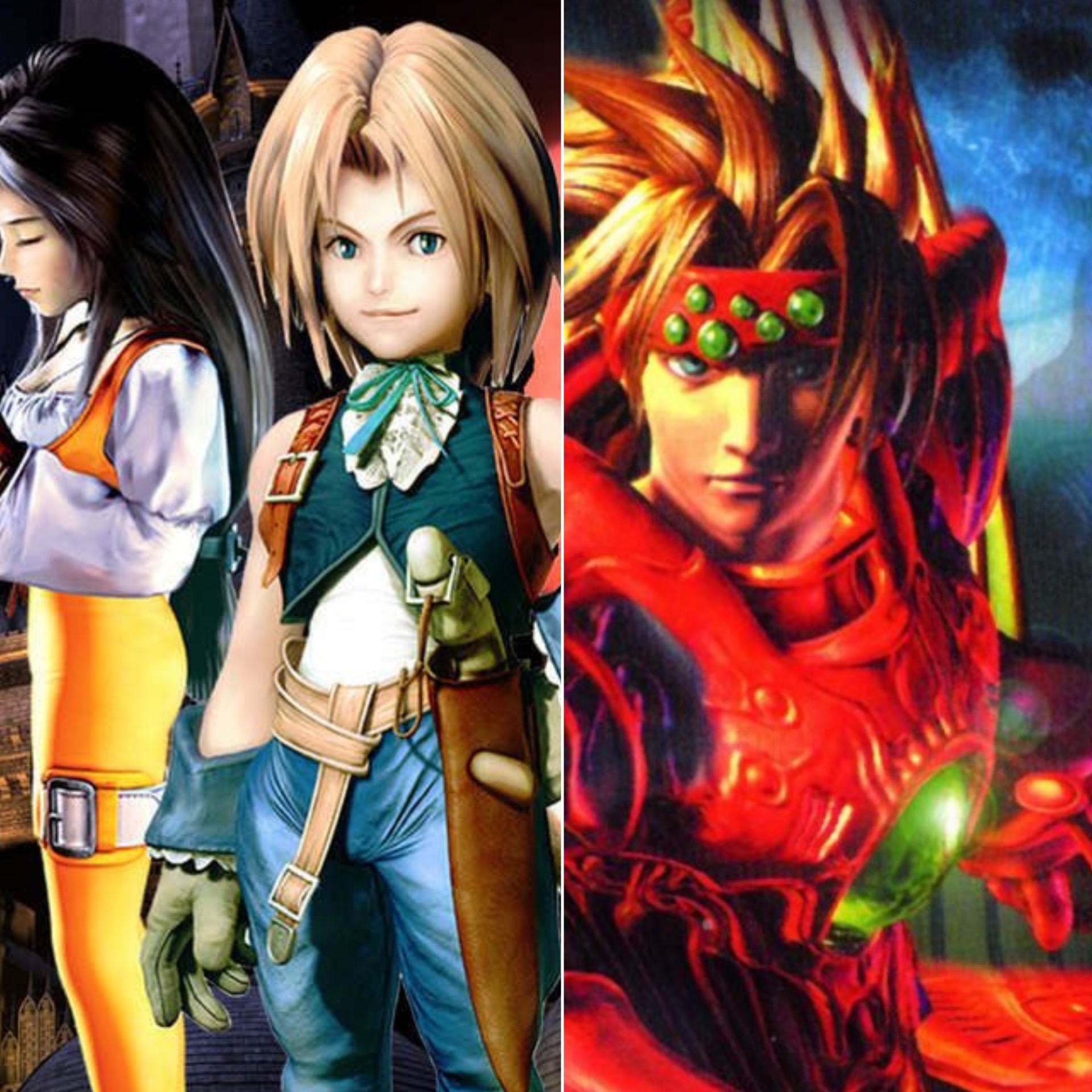So, what is the Ultimate Match? It is a new section on the Never Ending Realm where we pit two games against one another. We will judge the games based on visuals, story, music, gameplay, and critical reception, among other categories in order to determine a winner.
Why Final Fantasy IX vs The Legend of Dragoon?

Why not? Both JRPGs were multimillion dollar projects released in the year 2000. One was the last Final Fantasy on the PlayStation, while the other was Sony’s attempt to tap into the Final Fantasy (and JRPG) craze of the late 90s. The games competed against each other for gamer’s attentions (and wallets) during the late PlayStation 1 days. So, which game will come out on top?
Lineage
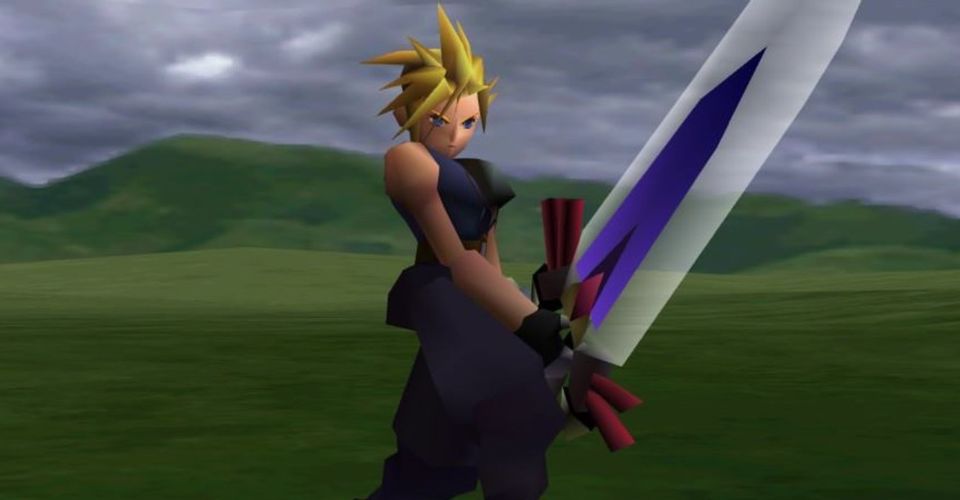
Final Fantasy IX: Truly, the 9th installment in the long running series has Japan Studio’s mega budgeted JRPG beat on this category. Final Fantasy IX is part of a long running series, one that also happened to be the most critically, and commercially awarded JRPG franchise prior to its launch. In terms of lineage and expectations, Final Fantasy IX had a lot to live up to, but consequently, it also a lot of fanfare before its release.
Apart from the Final Fantasy series, Squaresoft was known for delivering great JRPGs, games such as Chrono Trigger, Chrono Cross, and Xenogears paved the way for Final Fantasy IX to be hyped and receive the immense amounts of media and fan attention that it did. Expectations for Final Fantasy IX were high, and in terms of critical reception, it would exceed them all.
The Legend of Dragoon: The game is listed as the first JRPG under Japan Studio’s resume. If we don’t dig further, one could say that not much was expected from Legend of Dragoon before its release (despite the large budget, and massive ad campaign). But, digging further on Japan Studio’s credentials one will see that they had a hand in the development of Arc the Lad, Alundra, Wild Arms, The Granstream Saga, Legend of Legaia and other JRPGs of the era.
Apart from Alundra and Wild Arms, none of the former titles matched Square’s most brilliant efforts. Still, Japan Studio had a lot of experience in RPG development, thus at least lineage wise, The Legend of Dragoon seemed destined for success.
Winner: Final Fantasy IX.
Transporting myself back to the year 2000, if I had to buy one of these games based solely on their developer teams’ reputation, Final Fantasy IX would have been the clear winner. To be fair, no one could really compete with Squaresoft’s reputation for making great JRPGs at that time.
Visuals

Final Fantasy IX: Being that this would be Sakaguchi and Company’s final effort on the PS1 hardware, FFIX looks better than any Final Fantasy game that came before it. Thus, it was best looking traditional turn-based roleplaying game up to that point. Sharp pre-rendered backgrounds accompanied by wonderfully modeled 3-D characters were at the heart of the game. Also, the CG cutscenes were some of Squaresoft’s best, looking even more advanced than Final Fantasy VIII’s excellent cinematic scenes.
The Legend of Dragoon: It is here (in its graphics) where The Legend of Dragoon comes closest to matching Final Fantasy IX’s craftmanship. Legend of Dragoon follows Sqauresoft’s pre-rendered back grounds accompanied by 3-D character models formula. The Legend of Dragoon’s artwork, however, more closely resembles that of FFVII and FFVIII with realistically proportioned human characters, whereas Final Fantasy XI went for a super deformed fantasy look.
As a late gen PS1 game, very few games, let alone JRPGs can claim to look better than The Legend of Dragoon.
Winner: Final Fantasy IX.
As good as The Legend of Dragoon looks, Fina Fantasy IX just looks better. Maybe ‘better’ isn’t the right word, but more ‘polished’ would fit the bill. Final Fantasy IX has a real fully explorable 3-D world map, and Legend of Dragoon doesn’t.
Now, Legend of Dragoon is not the only JRPG from the era to feature a missing explorable ‘overworld’, but the game’s omission of it puts it at a disadvantage to Final Fantasy IX.
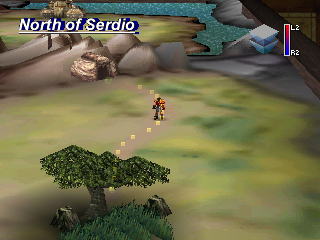
While 32-bit era overworld maps might seem a tad pedestrian today, back in the PS1 era, games with huge 3-D overworlds helped to sell the illusion of a cohesive game world to players in JRPGs. In terms of artwork, it is more difficult to pick a definite winner since both games have very distinct art directions.
Some gamers were turned off by the “kiddie” look of FFIX’s character designs. LoD’s more ‘realistic’ approach to its character designs will likely please these individuals. Beyond art styles, however, FFIX is clearly the more polished game.
Final Fantasy IX has a grander feel to every locale. Compare Alexandria’s castle to LoD’s Serdio and the difference in size and grandeur is staggering.
So, Final Fantasy will edge this category despite the fact that Legend of Dragoon was one gorgeous game in its heyday, at least in terms of technical prowess, Japan Studio’s RPG is in the same class as Square’s PS1 magnum opus.
Story
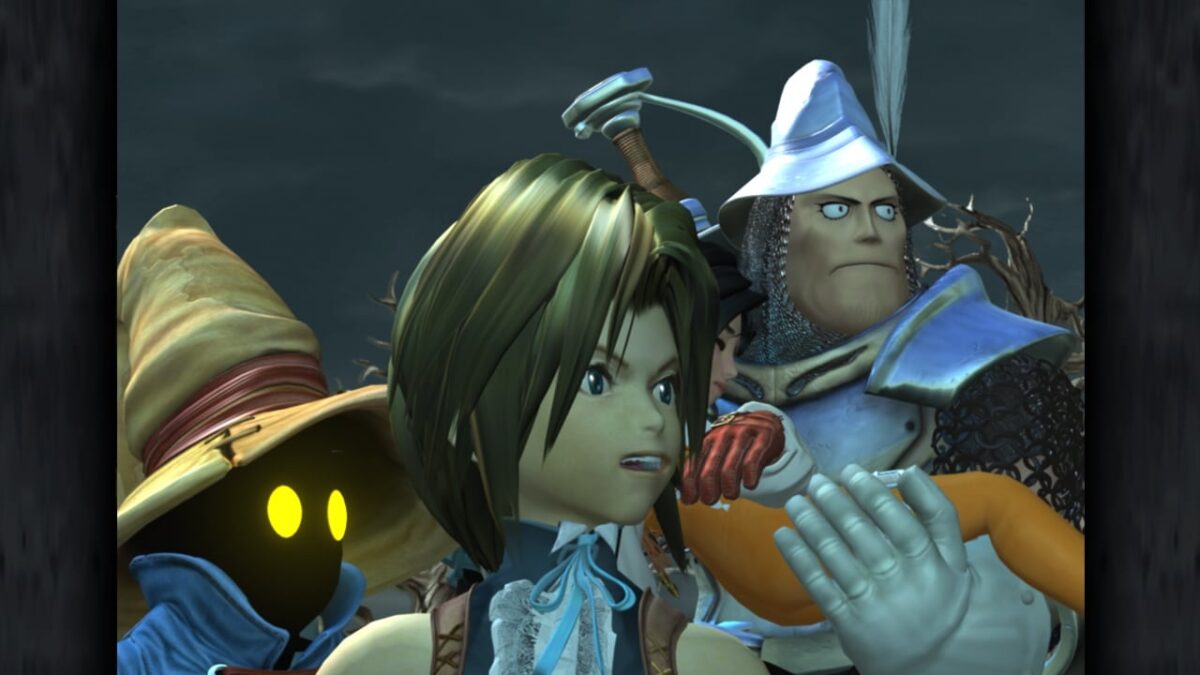
Final Fantasy IX: Final Fantasy IX’s story is not the greatest in the series. It could be argued that Final Fantasy VI, and Final Fantasy VII are more ambitious in the tales that they tell. In some ways, Final Fantasy IX takes elements from those titles, though its tale isn’t as dramatic as FFVI’s, or as fascinating as FFVII’s, FFIX does do a few things better than those former FF entries.
For starters, FFIX’s translation was by far the best that the series had seen up to that point, and consequently, light years ahead of the translation featured in The Legend of Dragoon which was legendarily awful.
Thanks to its translation and Sakaguchi’s growth as a storyteller, FFIX had the best written dialog in the series, and perhaps some of the best character development as a byproduct. Zidane and Kuja are not the most iconic Hero/Villain combination in the series, but they are certainly in argument for the best developed.
Then, you have characters like the heartwarming Vivi, and the overprotective (of Princess Garnet) more ‘righteous than thou’ Steiner (whose attitude makes him a viable comic relief at times). Final Fantasy IX is the definition of ‘polished’ and that applies to its storytelling too.
The game’s pacing is excellent, and there is never a dull moment in its adventure.
The Legend of Dragoon: If nothing else, The Legend of Dragoon story wise, is an ambitious piece of software. The story has a nice set up that goes back as far as 10,000 years (before the game starts) which chronicles the war between the Humans and Winglies. Humans, who had been enslaved by the Winglies (with the help of the Dragons) turned into Dragoons, and thus, were able to defeat their captors.
This was a relatively nice ‘setup’ for the story at the time. It lent a sense of importance to the game’s world that other wise it might not have had. The writers did a good job in laying the foundation for what could have been a great story, unfortunately, LoD falters in its delivery of it.
Legend of Dragoon’s issues start with its heavily cliched storyline. The reason that LoD scored low with most critics back in 2000, is simply that most of those critics had played JRPGs for years prior to experiencing LoD. I can include myself within that group, as LoD was far from the first JRPG that I had played, thus I was not impressed by anything that it did story wise.
At times, I have to wonder if the game’s awful (and I mean AWFUL) translation is really the largest culprit for the game’s story telling failures. Orthographic errors abound, and even some of the name choices for its characters are questionable. Still, it is hard to classify the game’s story as ‘great’ when even a certain party member’s death didn’t hit me in the ‘feels’.
The Legend of Dragoon really made an effort to copy Final Fantasy VII’s character troupes, but fell flat. Rose is an interesting character, and Dart while cliched a hero as can be, is not particularly unlikeable. Yet, the most remarkable thing about Legend of Dragoon’s plot is that despite taking place in a universe with great potential the game’s storyline itself is ironically completely unremarkable.
Winner: Final Fantasy IX.
A game’s narrative is sometimes difficult to properly judge. Unlike graphics which can be judged on a technical level, a lot of what makes a story ‘great’ is subjective to each gamer/reader. Based on my extensive experience with JRPGs prior to playing The Legend of Dragoon, I found its plot predictable and pedestrian for the most part.
That said, I can see how the game has gathered a cult following over the decades. It has an interesting universe, and the story has grand aspirations that would have been impressionable on the younger crowd two decades ago, and perhaps, on older games who hadn’t played many JRPGs prior to experiencing LoD.
Final Fantasy IX is different. Unlike LoD, it had little to no orthographic blunders, and the localization team at Squaresoft delivered one of its finest efforts at the time. Final Fantasy IX was truly a character journey, there was a deep plot behind it, but not as grand as The Legend of Dragoon’s own storyline hinted at being.
Squaresoft mastered the art of proper storyline pacing in FFIX, and there was never a dull moment. The game kept me gripped as I wanted to see what fate awaited Zidane, friends and even the game’s villain, Kuja, which was much better written than LoD’s Lloyd (yeah, what a fear inspiring name for a villain).
The Legend of Dragoon was the first full blown JRPG effort by Sony’s Japan Studio and it showed in the poor writing quality of the game. In contrast, FFIX was Squaresoft’s 9th installment in its crown jewel franchise, and consequently, it couldn’t have been more polished in telling its story.
Music
Final Fantasy IX: Nobuo Uematsu crafted another masterpiece. Final Fantasy IX wasn’t as strong (musically) as Final Fantasy VI (which has a good argument as being Uematsu’s best work) or Final Fantasy VII. However, apart from those two games in the series (and maybe FFX) Final Fantasy IX is the best sounding game in the franchise.
Melodies of Life remains one of my favorite tracks in the series, and the different variations of its melody throughout the game are brilliant.
The Legend of Dragoon: Even with two composers the Legend of Dragoon has a fairly mediocre, and forgettable soundtrack. I don’t like to disrespect the dead, and I feel stronger about that when the dead person died way before his/her time due to a tragic illness. So, I will just say that Takeo Miratsu (who passed away in 2006) had a bad spell, in an otherwise good career as an Anime and Game Composer though LoD was his first JRPG.
Perhaps Miratsu isn’t to blame, as The Legend of Dragoon is one of the weirdest JRPGs out there as far as musical score is concerned. Miratsu, wasn’t the game’s main composer, that job would fall on one, Dennis Martin.
If “Martin” doesn’t sound like a Japanese name to you, it is because Dennis Martin is not Japanese. He was actually hired by Sony in a strange twist of fate. Even though Legend of Dragoon copied the Final Fantasy series (mostly FFVII) in every imaginable way, Sony felt that the game needed to have a ‘distinctive’ score in order to differentiate itself from its competitors. Thus, hiring a western composer seemed to be the ideal thing to do. Miratsu would be brought in later, as the game was too vast for only one inexperienced composer, which in terms of game score composing, Martin was.
Martin did compose the ending theme “If You Still Believe” which to his credit was far and away the best song in the whole game, but this “good” track wasn’t enough to save the rest of the pedestrian score from mediocrity.
The soundtrack lacked cohesiveness, and it just didn’t have any memorable melodies that stuck out to me. Truly, Dennis Martin’s abysmal effort showed that you just couldn’t walk into game development as a musician and conquer someone like Uematsu in your first attempt.
Winner: Final Fantasy IX.
Honestly, unless your JRPG has a composer that goes by the name of Yasunori Mitsuda (Chrono Cross, Xenogears, Chrono Trigger), your game will not win a musical contest against a Final Fantasy game helmed by Nobuo Uematsu.
Gameplay
Final Fantasy IX: Being the series’ 9th entry, FFIX plays it safe. Truth be told, coming off Final Fantasy VIII’s divisive Junction system, FFIX’s return to “roots” and simpler character progression was hugely welcomed. Final Fantasy IX is a game that I would easily recommend to newcomers to the genre.
Unlike previous entries, there is no customizable classes for the game’s party members, instead we are back to Final Fantasy VI’s ‘inborn’ classes. Whatever the party member is in the story (Black Mage, Knight, etc.) that’s the skill set that the party member will have at his or her disposal.
Abilities (matching the character’s inborn class) are learned through equipment. Once an ability is mastered is not necessary to keep that piece of armor/weapon equipped. The system is straight forward. Grind and succeed.
Exploration is done the same way that it has always been done in FF games. Traverse pre-rendered backgrounds representing towns and dungeons. When out of those areas the game features a gorgeous (at the time) fully explorable 3-D overworld.
Final Fantasy IX introduces the ATE (Active Time Event) system into the series, which is nothing more than Square Enix’s take on the ‘Skits’ present on the Tales’ series. These optional ATEs help to develop the characters at different times of the playthrough.
Finally, Final Fantasy IX has a decent amount of side quests including a card game that is not as significant to the game as Final Fantasy VIII’s, but fun, nonetheless.
The Legend of Dragoon: Apart from the ability to transform into a Dragoon in mid combat, and the Additions (Quick Time Events) system, The Legend of Dragoon, much like Final Fantasy IX, plays by the 101 JRPG book.
Players explore pre-rendered towns and dungeons much in the same way that they would explore the game’s PS1 Final Fantasy counterparts. However, The Legend of Dragoon does not have an explorable 3-D overworld. Instead, it has an ugly 3-D map that you traverse in linear ‘connect the dots’ fashion.
In terms of traversal, exploration, and side quests, Legend of Dragoon is greatly inferior to Final Fantasy IX. Surprisingly, Japan Studio made some nice strides in the game’s battle system. While Character progression is fairly straight forward, the ability to turn into a Dragoon by attaining spirit points provides a nice change of pace.
Turning into a Dragoon raises the party member’s attack and defense stats, but the power has a limited number of turns. This ability was a lifesaver during some of the tougher boss fights. Everything is government by successfully performing Additions. Additions are timed button patterns that need to be pressed in order to perform powerful attacks. Additions get progressively more complex as they get more powerful, and the system helped to keep me on my toes no matter how powerful my cast became from hours of fighting.
I would be lying if I said that I didn’t have fun with The Legend of Dragoon’s battle system.
Winner: Final Fantasy IX.
The Legend of Dragoon has the better combat system (even if it is not as polished), and battles can take a long time which after the 30-hour mark can get a bit tedious since the story isn’t good enough to carry the day. Apart from that, it is likely that most will find the same joy within FFIX’s more refined (tried and true) battle system, and a much better time exploring the game’s environments and side diversions.
Critical Reception
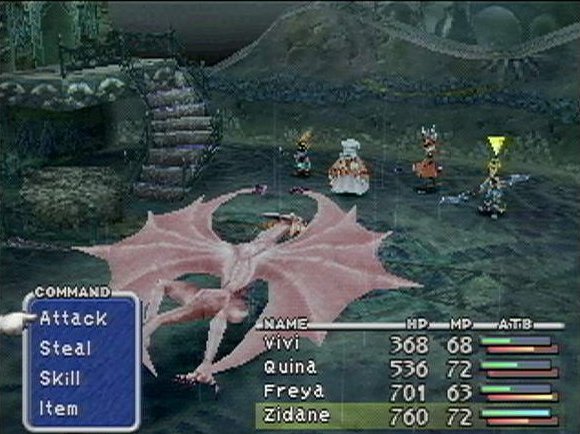
Final Fantasy IX: It is odd that Final Fantasy IX is not talked about (for the most part) in the same breath as Final Fantasy VI and Final Fantasy VII are talked about amongst most Final Fantasy Fans. Ironically, Final Fantasy IX was better received by critics than the former two classics. Holding a 94 Metacritic rating, Final Fantasy IX remains the highest rated FF game.
I scored the game a 10/10 in our review two decades ago, and I even voted the game as the best Final Fantasy game ever (even though it is not my favorite). The game also holds a 9.0 approval rating from fans on its Metacritic page based on 1334 ratings.
The Legend of Dragoon: Legend of Dragoon was not well recieved by the critics of its time. The game had the misfortune of being released at the peak of the genre’s golden era, and there were far better games being launched frequently (even if they had lower budgets). Its biggest misfortune might have been that its release coincided with Final Fantasy IX and Chrono Cross’ own launches as the three games were released within the same year.
Holding a 74 Metacritic rating, The Legend of Dragoon is firmly entrenched as an average JRPG in the critical world. Surprisingly, its fan rating on Metacritic i much better, standing at an 8.9, which even then remains .1 lower than FFIX’s own fan rating.
The catch in The Legend of Dragoon’s fan rating is that it only has 354 ratings. Thus, showcasing that there is a loyal cult following for the game, but it is not numerous enough to merit the game’s much awaited “remake” by its loyal fan base.
Winner: Final Fantasy IX, and it isn’t close in this category.
Legacy
Final Fantasy IX: By selling 5.5 million units, which was an impressive number given that its release coincided with the PlayStation 2’s own, FFIX was an instant success. The game has been ported in remastered form to every modern system available, and while it is not likely to be remade any time soon (there is a greater interest in Final Fantasy VI being remade), its chances of eventually getting one are actually better than The Legend of Dragoon’s odds.
The Legend of Dragoon: With 1.3 million units sold, The Legend of Dragoon is hard to describe as a commercial failure, but Sony’s handling of the IP over the last two decades points to the game’s sales numbers as being a tad misleading.
For starters, other franchises have spanned sequels with worst numbers, but none of those games had the multi-million dollar development and marketing investment behind them. The Legend of Dragoon was expected to pull off FF numbers, and it didn’t come close. Sony has kept the door shut on any ‘Remaster’, and Remake talk.
Sony’s recent closure of Japan Studio all but ensures the death of an official The Legend of Dragoon Remake. While its fans have been very vocal, a 2 month old petition on Change.org has only gathered 6000 signatures. By contrast, a petition for a Days Gone sequel attained 50,000 in a few days, thus it is unlikely that Sony will feel pressured into bringing back its forgotten IP.
Winner: Draw.
Final Fantasy has the better legacy as a game. It was just a much better JRPG, and it has been remastered for every modern system. However, it doesn’t have the mystique or sacred reputation that other titles in its series have.
There is a saying that states that, “absence makes the heart grow fonder”, and I have never seen are more vocal, and passionate group of fans than the cult of followers supporting The Legend of Dragoon, and the game’s seemly impossible quest to get remade.
In the end, I have a feeling that The Legend of Dragoon will remain a hot topic within gaming forums, and its fan base will continue to demand a ‘Remake’ for years to come, which will keep the game as relevant as Final Fantasy IX in the social media world.
Final Tally
Final Fantasy IX-6 (and 1 even)
The Legend of Dragoon-0 (and 1 even)
Agree with the author? Couldn’t disagree more and are frothing at the mouth to tell him? Leave a comment here, on Facebook or send an email and make sure to follow Never Ending Realm on Facebook, Twitter, and YouTube!
